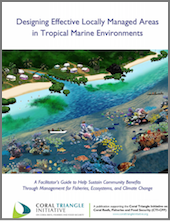Designing Effective Locally Managed Areas in Tropical Marine Environments: A Facilitator’s Guide to Help Sustain Community Benefits Through Management for Fisheries, Ecosystems, and Climate Change

Introduction
All communities want to live among healthy and abundant natural resources that provide many benefits, including food, income, medicine, and cultural value. However, coastal people throughout the world are now noticing severe impacts to their valuable natural resources, caused by both climate change and local threats. Over time, climate change will intensify the negative impacts from human activities that affect natural resources; for example, pollution from land clearing and declining populations of fish from overharvesting (Parry et al. 2007).
Purpose This guide was developed to help improve the design of Locally Managed Areas (LMAs). Specifically, this guide will support facilitation of community processes for LMAs including:
- Outreach to understand key ecological and social factors that contribute to healthy and abundantresources, and the latest science-based recommendations for managing resources so they arehealthy, abundant, and resilient; and
- Planning steps to develop zones and rules for LMAs that will help to build long-term healthy,abundant, and resilient coastal and marine resources
This Facilitator’s Guide is designed for use by small planning teams consisting of people from communities,agencies, and organizations that normally facilitate stakeholders through community-based planningand implementation processes. Stakeholders include community leaders; community members whoutilize or depend on coastal and marine resources; and/or agencies and organizations that have jurisdictionover or a supporting role in these areas. The guide can be used in areas that already have an LMA andwant to improve its effectiveness and resilience, or as part of the design process for a new LMA ornetwork of LMAs (see Figure 1).
This guide supports communities to undertake ecosystem-based adaptation (EBA) to climate change. EBA is defined by the Convention on Biological Diversity (CBD) as the “use of biodiversity and ecosystem services to help people adapt to the adverse effects of climate change” (CBD 2010). As further elaborated by Conference of the Parties to the CBD Decision X/33 on biodiversity and climate change, this definition also includes the “sustainable management, conservation and restoration of ecosystems, as part of an overall adaptation strategy that takes into account the multiple social, economic and cultural co-benefits for local communities” (CBD 2010). For coastal communities, opportunities—such as this guide—that improve management and maintain (or improve) the resilience of critical ecosystem services help people and communities adapt to the negative effects of climate change through EBA
Suggested citation
Gombos, M., Atkinson, S., Green, A., & Flower, K. (Eds.). (2013). Designing Effective Locally Managed Areas in Tropical Marine Environments: A Facilitator’s Guide to Help Sustain Community Benefits Through Management for Fisheries, Ecosystems, and Climate Change. Jakarta, Indonesia: USAID Coral Triangle Support Partnership.
(0) Comments
There is no content